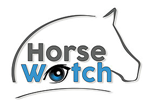HorseWatch - Our methods
Stress
Stress reactions of horses during initial training sessions are assessed by measuring the stress hormone cortisol in the horse's saliva and through continuous recording of the heart rate.
Activity
Activity sensors are used to monitor horse’s movements in different housing systems and training phases. Additionally, changes of activity patterns are investigated over different ages and increased training intensitiy.
Behavior
Behavioural observations are used to assess the well-being of horses in relation to initial training. In addition, is it evaluated how husbandry systems and age at the start of training affect behavioural patterns.
The data collection includes among others the determination of electrical activity in the cerebral cortex using electroencephalography (EEG).
Performance
Regular performance tests, which include measuring the heart rate and lactate values in response to a standardized training, are used to assess the impact of the horse’s fitness level. The effects on fitness levels are investigated over the course of the initial training, as well as the impact of husbandry system and age.
Health
Regular health examinations of the horses, which include x-rays, are used to show the influence of training at a young age as well as different husbandry systems have on the long-term health of horses.

